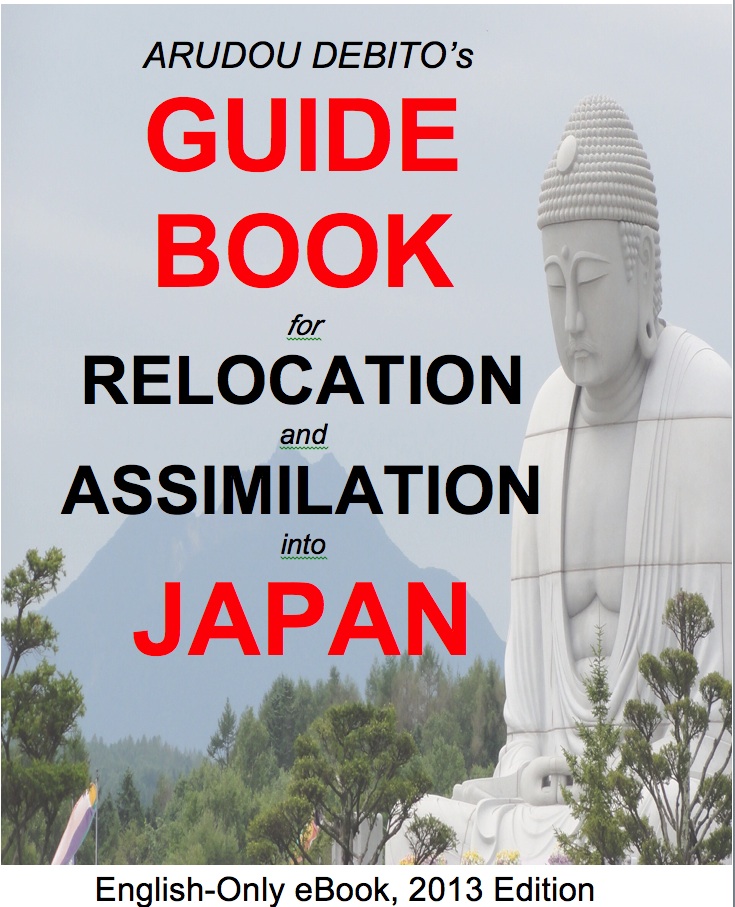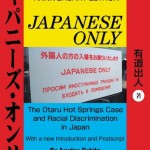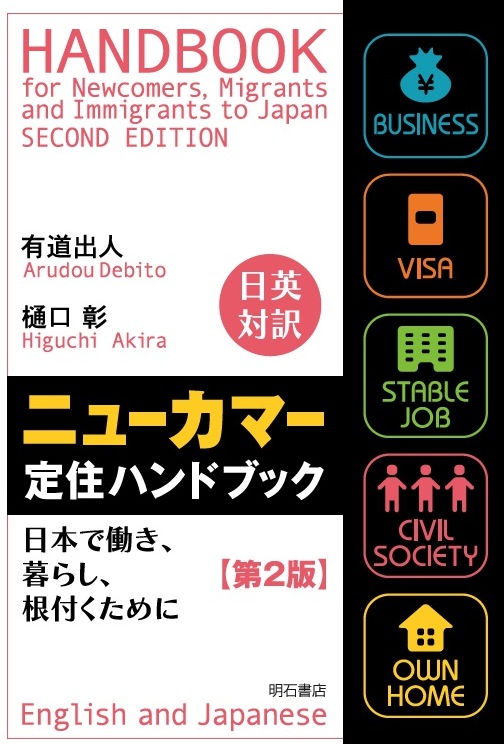mytest
Books, eBooks, and more from Dr. Debito Arudou (click on icon):





![]()


UPDATES ON TWITTER: arudoudebito
DEBITO.ORG PODCASTS on iTunes, subscribe free
“LIKE” US on Facebook at http://www.facebook.com/debitoorg
https://www.facebook.com/embeddedrcsmJapan
http://www.facebook.com/handbookimmigrants
https://www.facebook.com/JapaneseOnlyTheBook
https://www.facebook.com/BookInAppropriate
If you like what you read and discuss on Debito.org, please consider helping us stop hackers and defray maintenance costs with a little donation via my webhoster:

All donations go towards website costs only. Thanks for your support!
Hi Blog. As an antidote to the program talked about last blog entry, where hunting NJ for public amusement and sport became yet another TV show, here’s a relatively rare article showing the good that NJ do for Japanese society: revitalizing communities that are dying, as they age and endure an exodus of their young to more prosperous cities. The article is a bit too optimistic to be realistic (given that all this progress could be undone with a simple mass cancellation of visas and government repatriation bribes; the former has happened multiple times in Japan’s history), but I’d rather have the article than not. Have a look and tell us what you think. Dr. Debito Arudou
/////////////////////////////////
In rural Japan, immigrants spark a rebirth
Newcomers fill the labor and tax void as young Japanese bolt to Tokyo
YUSUKE SAKURAI, Nikkei staff writer
March 21, 2018
https://asia.nikkei.com/Economy/In-rural-Japan-immigrants-spark-a-rebirth
PHOTO CAPTION: Nearly half the students at Keiwa Elementary School in Tsu, Mie Prefecture, have at least one parent from another country.
(Courtesy of this Nikkei article)
TOKYO — In roughly three decades, the number of foreign residents in Japan has grown to 2.47 million, from just 980,000 in 1989. So while this period will go down in history as the time the country’s population went into decline, it has also brought an unprecedented influx of newcomers from abroad.
Tagalog, Portuguese, Spanish, Thai, Indonesian: The students at Keiwa Elementary School in the southwestern prefecture of Mie speak nine different languages at home. But at school they use Japanese.
“This is how you draw an equilateral pentagon,” one non-Japanese sixth-grader said nonchalantly in February. “Can you pass me a protractor?” asked another. Their fluent Japanese had no detectable accent.
Nearly half the school’s 250 students belong to at least one non-Japanese parent, making the school a microcosm of rural Japan’s new diversity.
The subject of Japanese demographics calls to mind an aging society, a falling birthrate, population decline and rural decay. And yet, under the radar, the increase in immigration has been changing pockets of the country, energizing smaller municipalities that were desperate for labor and tax revenue.
There was a time when Keiwa Elementary’s student body had dwindled to just one-seventh of its peak. But thanks partly to a rise in the number of foreign residents working in the nearby Chukyo industrial area, its classrooms are buzzing again.
Kevin Sahayan, a student from the Philippines, said he started learning Japanese when he enrolled in third grade, upon his arrival in the country. “Now that I have learned Japanese, I have more friends and I have fun playing soccer after school,” the 12-year-old said.
“Guess which nationality I am!” children asked as, one after another, they pulled the sleeve of this puzzled reporter.
“You probably won’t get it so I will tell you. I’m half-Filipina and half-Japanese. That girl over there is Japanese, and that one there …,” explained student Ai Maruyama. Asked whether she feels “different” in the environment, she said, “No, not at all.”
In Mie, overall, the number of non-Japanese newcomers more than offset that of residents who moved to Tokyo last year — 5,999 versus 5,907.
This is no small point, considering that the government is struggling to stop the hollowing out of regional industry. Nationwide, around 120,000 people relocated to the Tokyo area in 2017, mainly for education or work, according to the internal affairs ministry. It was the fourth straight year in which the figure topped 100,000, even though the government aims to reduce it to zero by 2020.
But in Gifu and Shiga prefectures, which are adjacent to Mie, increases in residents from abroad made up for 80% of departures in 2017.
In Gifu, local housing company Sunshow Industry has been helping non-Japanese residents purchase homes for five years. Its office in the city of Kani has a sign at the entrance in Portuguese, inviting passers-by to come in for a consultation. Twenty-percent of its customers are foreign nationals.
One Sunday in February, a Brazilian man came in, looking for a house that would be big enough for his family. “I have kids aged 20 and 18, so I want a house where we can have lots of breathing space,” said the 43-year-old crane operator, who has lived in Japan for about two decades.
Sunshow started catering to international residents, mainly from Latin America, as more and more came to work at a Sony subsidiary’s plant in the city of Minokamo. Unlike the kids at Keiwa Elementary, though, adults are not always so quick to overlook differences.
“Five years ago, if a Latin American tried to settle in their neighborhood, there would be many residents who would protest it,” said Toshiyuki Shiraki, who finds land for Sunshow. In some cases, the hostility persisted even after international workers moved in. A major point of contention was seemingly minor: some newcomers’ failure to separate their trash in accordance with the rules.
But Shiraki said the tensions appear to have largely subsided, after a greater effort was made to explain the local ways. Now, Japanese residents seem less averse to sharing their neighborhoods.
Even now, foreign residents make up only about 2% of Japan’s population of 127 million, but in certain places the ratio is quite a bit higher. It exceeds 5% in 31 municipalities; the town of Oizumi, in Gunma Prefecture, had the highest share of 17% as of January.
Three municipalities, including Tokyo’s Shinjuku Ward and the northern village of Shimukappu in Hokkaido, had ratios over 10%.
Other communities have taken notice of how foreign residents offer vital manpower for companies and more tax revenue for local governments. Some are actively courting immigrants.
The Hokkaido town of Higashikawa set up a Japanese language school to encourage young foreign residents to come, particularly those from other parts of Asia, like Taiwan. This is the first school of its kind run by a Japanese municipality.
The city of Mimasaka, in the western prefecture of Okayama, plans to open a sister school of Vietnam’s University of Danang.
Foreign nationals tend to gravitate to places where their children are likely to receive better education. Mie — home to Keiwa Elementary — is a testament to this. The prefecture is gaining a reputation for supporting students born to non-Japanese parents. “Mieko san no Nihongo,” a textbook for teaching classroom Japanese developed by the Mie International Exchange Foundation, has proved useful in this regard and is now used in elementary and junior high schools nationwide.
According to the Ministry of Education, the number of students requiring additional instruction in the Japanese language at public elementary and junior high schools topped 30,000 for the first time in the year ended March 2017.
The central government, too, is looking to bring more foreign workers into the country. Prime Minister Shinzo Abe last month said his government will design a reform plan for this purpose by the summer. Yet Abe is not exactly jumping in with both feet — the policy will not encourage permanent settlement, with a cap to be placed on the maximum stay and restrictions on bringing family members along.
Even so, Japan is far more diverse than it was in 1950, when there were only 600,000 residents from overseas. From large cities to tiny villages, Japanese grow ever more accustomed to mingling with their fellow global citizens. And the newcomers are breathing life into communities that looked destined to fade.
ENDS
============================
Do you like what you read on Debito.org? Want to help keep the archive active and support Debito.org’s activities? Please consider donating a little something. More details here. Or even click on an ad below.

7 comments on “Nikkei Asian Review: “In rural Japan, immigrants spark a rebirth”. An optimistic antidote to the regular media Gaijin Bashing”
‘A major point of contention was seemingly minor: some newcomers’ failure to separate their trash in accordance with the rules.’
Yeah, it is minor. These are the people that are going to pay your pensions.
Although I’m interested to know, what’s going to happen when these ‘Japanized’ NJ kids graduate school, move away to university, and just like all the Japanese kids, decide that they don’t want to be farmers?
The agricultural system of Japan has been unsuitable for decades and has only survived this long due to protectionism, vested interests, huge amounts of vote-buying subsidies, and is collapsing as we speak due to demographics. This isn’t a solution, this is an attempt at kicking the can down the road for one more generation.
I stopped taking this seriously when I read that they were teaching Nihongo (“Mieko san no Nihongo”) – and not kokugo – to the foreign students. When will the Japanese ever learn? Wait. Don’t answer that. I already know the answer.
JP,
I don’t see anything inherently wrong with that distinction. In English-speaking countries, ESL and ELA are treated as different subjects.
Of course, Wajin racists are incapable of distinguishing language ability and race, so instead of referring to non-native speaking children as such, they slap the label “foreign” on them, as you did as well. They are not “foreign” children; they are non-native speakers of Japanese. Let’s not play along with the Wajin ethnocentrism.
The Wajin author of this article, and to a certain degree Dr. Arudou as well, have praised what Mie is doing, but I did very cursory research, and the program is, as a whole, still steeped in racist hogwash.
First, the Mie government is labeling these schoolchildren as “foreigners.” This is a huge problem. They are children living, growing up, and attending school in Japan. They are not foreign exchange students. They are just as Japanese as the other kids. We do not need to slap a label on them and separate them from others.
Second, have a glance at the actual “textbook” touted in this article.
I’m sure you’ll notice it’s being published by an “international exchange” organization. Educating schoolchildren in their own country of residence is not “international exchange.” They are not foreign diplomats; they are schoolchildren. Again, unnecessary racist labeling and othering.
Additionally, the text is the usual foreign language textbook style, centered around a group of “characters” who are used to demonstrate dialogue and the like. And wouldn’t you know it, there are two Wajin girls, and their names are written in hiragana, but the minority students are slapped with a country label (Brazil, Peru, etc.), and their names are written in katakana.
This is not the kind of education and assistance with assimilation that minority children need. This is teaching them from day one, down to the way they write their name, that “You are different, you are not one of us, this is not ‘your’ country, you do not belong here.”
A look at the second text reveals even more racist insanity. The teaching style is the same used to teach Japanese to adult English speakers, where Japanese grammar is misconstrued to make it similar to English. (For example, calling keiyoushi and keiyoudoushi “i-adjectives” and “na-adjectives,” or labeling a combination of verbs and helping verbs as “negative form,” a distinction that does not exist in kokugo.) This is so deeply embedded they literally add English annotations to the Korean translations of vocabulary words in the index at the end. I could not make up something that stupid if I tried.
I have no idea how similar the grammatical structures of English, Thai, Chinese, and Korean are, but I imagine there are some significant differences that make taking a bastardized form of Japanese adapted to be easily understood by native English speakers and then translating it into a third language that is similar to neither Japanese nor English seem more than a bit stupid. All I can say is I bet it will be painfully confusing to have to re-learn Japanese grammar when the kids hit middle school and start studying it. (I speak from experience.)
I could go on, but I’m belaboring the point. It’s all ignorant racist garbage. I don’t see anything to celebrate. Sorry to rain on the parade.
— Not at all. Thanks for this.
Thanks for the comments, HJ. I agree with a lot of what you wrote, but the comparison of Nihongo to ESL is not really apples-to-apples. In Japanese linguistic circles, “Nihongo” is a special version of Japanese taught to people who, by dint of their race or ethnic background, are deemed incapable of every really understanding real Japanese – or kokugo. Sure, ESL programs target people with less-than-native English ability, but those programs do not seek to teach a watered-down version of English to those people and do not asssume, from the outset, that those people are, by dint of their race or background, unable to fully understand standard English.
Japanese language teaching in Japan and abroad still suffers largely from this distinction. With a few minor exceptions, many Japanese books still aim to teach foreigners some hybrid form of Japanese that lies somewhere between actual Japanese and English (you hit on some of this in your discussion of the textbook used in Mie-ken). These books are usually peppered with phrases that mimic English conversations like “O-genki desu ka” and, likewise, needlessly include subjects for almost all sentences. This is, of course, a natural extension of stereotyped thinking about race and language that extends back quite a ways. Japanese language schools that cropped up after WW2, for example, were almost exclusively open only to Asians. The notion that you should or could teach Japanese to Westerners was foreign to the Japanese and, in the cases of many Japanese teachers domestically and abroad, oddly enough, still is.
I am obviously sympathetic to the point you are making about not labelling people as “foreign,” but I don’t think it does any good to word-police the use of the word “foreign” when describing actual foreign children within the context of this kind of article (the article even explains that these are “foreign residents” of Japan – i.e., children with foreign nationality). I think we can recognize that fact as a legal matter while also making room for the important issues of identity you righly bring up. This point is especially important, I think, when discussing these matters with Japanese. Most Japanese will not take your argument seriously if you don’t at least concede that, as a matter of nationality, these students are not Japanese.
By my lights, the ethnocentrism we should really be worried about is the automatic impulse of a vast majority of Japanese to categorize based on race and looks alone. And on that score, we are unfortunately fighting an uphill battle, although one that I fight just about every time I encounter it. At least for the foreseeable future (if not forever), the Japanese will continue lumping people of a certain race or phenotype into one general category. That is simply a feature deeply-woven – or embedded – into the fabric of almost every level of Japanese society.
Given that, what we should be doing is trying to make Japanese understand that, no matter what color person you are dealing with or what country they come from, you should check your cultural steretypes and baggage in at the door and treat people as individuals. What this means as a practical matter is that, at a bare minimum, Japanese should speak Japanese and do away with the discriminatory impulse to use English with “apparent foreigners” (or refrain from doing so until the “apparent foreign” gives at least his or her tacit approval to speaking English) and do away with the long, annoying script of questions and stereotypes that dictate how Japanese should or can interact with foreigners. I am much more concerned at slowly chipping away at that glacier of a problem than anything else.
JP,
I apologize for the delay in my response. Thank you for an excellent reply.
I am aware of the current racist undertones of Nihongo instruction (as opposed to Kokugo), and I apologize for not being clear with my original comment. I only intended to convey that the nominal difference–that is, labeling Japanese language instruction intended for non-native speakers’ acquisition of the language with a different term than instruction intended for native (or fluent) speakers, intended to broaden and enrich their grasp and usage of the language. On that (superficial) level alone, I have no qualms with the distinction.
If anything, I suppose I should have known beforehand without looking that the nature of the Nihongo “text” used in Mie was in line with the racially-charged Nihongo instruction to which you referred in your reply. I have no objections to the title of “Mieko-san no Nihongo” in and of itself. The problem, of course, lies in the racist nature of the content, as you astutely indicated.
It’s the last paragraph of your reply that really hit the nail on the head for me, though. Rather than getting caught up in nominal identities, the ultimate goal is indeed to treat persons as individuals and interact with others based on each individual’s personality, instead of lumping all into a group with a uniform (racist) approach. Indeed, whether a person is Japanese or not is not terribly relevant–the misguided thought that it is of utmost importance and relevance in determining how to interact with others is very much at the core of our troubles as minorities.
“And on that score, we are unfortunately fighting an uphill battle, although one that I fight just about every time I encounter it.”
This line particularly caught my attention. I am constantly pondering my reactions to the racism I encounter. My approaches have changed with time, and I am sure there is no one-size-fits-all approach, but I would love to know how others are handling the problem. How do you respond to the usual “Where are you from?” “Your Japanese is so good!” questions, or Wajin who try to use English in some way?
By the way, if you’re involved in any activist groups or other activism outside of your daily personal interactions, I’d love to know about it.
Thanks, HJ.
I had written this great reply to you and then accidentally closed the browser tab. Ugh.
Anyway, long story short is I agree with everything you wrote in your post. Re the Nihongo-Kokugo issue, I would probably feel comfortable with a designation like JSL, but Nihongo comes loaded with so many stereotypes that I automatically become suspicious when I see it used. Of course, I have to temper this knee-jerk reaction sometimes because there are some very good Nihongo textbooks and teachers out there doing there best to promote integration and the teaching of real, natural Japanese. I am very grateful for their efforts. (One of my favorites is Youhei Arakawa (荒川 洋平). Would definitely recommend his book, “もしも…あなたが外国人と「日本語で話す」としたら とりあえず日本語で”, if you have the time. He is one of the few Japanese I know who really “gets it” when it comes to the sort of issues we are talking about.)
And a big yes to your point about treating people as individuals. The final paragraph in my last message was pretty much my back-of-the-napkin approach to all of the issues we have been talking about. A country that separates people into different “castes” based on physical appearance is not really sustainable as an integrative society and will never really attract visible minorities. A lot of lip service is paid in Japan to the want to “internationalize,” but no meaningful effort is really put into this. A lot of companies are trying to incorporate English as their company language now, but that sort of misses the point. They are still protecting their own language and culture from the “others” they will be working with. If those “others” do not feel a sense of inclusion, they will never invest the time and energy to make those companies truly global.
Great question about my reaction to racism. It usually saps me of energy, but I usually react to racism head-on. A lot of foreigners try to react the “Japanese way”, whatever that means. To most foreigners that means shutting up and taking it all on the chin, but life is too short and nothing will ever change if people do not speak out about mistreatment. I think Edward Seidensticker said it best with the following line:
“The Japanese are just like other people. They work hard to support their—but no. They are not like other people. They are infinitely more clannish, insular, parochial, and one owes it to one’s sense of self-respect to retain a feeling of outrage at the insularity. To have a sense of outrage go dull is to lose the will to communicate; and that, I think, is death. So I am going home.”
Anyway, about my specific responses. If someone asks me where I’m from, I tell them something like “I am originally from XXX, but I have already lived in YYY, Japan for over ZZZ years. (もともとはXXXから来ているのですが、もう既にYYYにZZZ年以上住んでいます。). I find that this is a good way to shift the conversation back where it should be and communicate to the person that there are such people as “long-term residents of Japan.” If they tell me how good my Japanese is, I usually say something like “No, YOUR Japanese, rather, is the good one” (いや、そっちこそ日本語が上手ですよ。) or I’lll say something like “It should be. I’ve already lived here for XXX years. Anyone who has lived in Japan this long can learn Japanese.” (そのはずなんですよ。もうXXX年も日本に住んでいますから。これだけ日本に長く住んでいれば、誰でも日本語を覚えられますよ。). I especially like the last one because it pushes back on the myth that Japanese is SUCH A DIFFICULT language to learn. This usually makes them uncomfortable, and I can explain to them that Japanese is not as hard of a language to learn as they believe it is.
How do you usually deal with these perennial questions?
As for activism, I am not involved in any activism (beyond my own daily battles – lol) or activist groups at this point, but I would like to get involved with them in the future. Japan can be a stressful and isolating place to live (one of my favorite Debito quotes of all time – bar none – is from an interview on the podcast “Deep in Japan,” where Debito so aptly explained that “Living in Japan is like living in a pool of slow-burning acid, where the constant alienation slowly but surely eats its way through your defenses and you realize after the end of it that it’s reached your bone and it’s really beginning to hurt.” [https://soundcloud.com/deep-in-japan/debito-racism-in-japan]), so I think it’s important that foreigners support each other and try to make life better for the generations that come after us.
Are you involved in any activism or activist groups?
Is no one else seriously perturbed by this (Wajin) author slapping the label “non-Japanese” on elementary schoolchildren? They’re children living, growing up, and attending school in Japan. They are Japanese children, full stop.
The anecdote about the children running up to the reporter to notify him of their nationality is likewise very disturbing. Right now, it’s just a way for them as children to express their identity and find something unique about themselves, and their peers are too young to care. The label has no weight or consequence to any of them. And, of course, their school teachers and administrators are almost entirely racist nutjobs who think it only natural that the children be slapped with these labels, and would never once think to guide the children to awareness of the fact that they are also Japanese. This is extremely troubling.
Growing up being labeled as “non-Japanese” will quickly prove highly detrimental to their ability to be an equal member of society when they enter middle school and start being inundated with nihonjinron racist propaganda, prescribing what a “real, pure” Japanese is like, and endlessly asserting that they, the “non-pure” are inherently different/inferior/incapable of understanding Japanese/Japanese society/”Japanese culture” (as prescribed by right-wing Wajin racists).
When they go to high school, the nihonjinron propaganda will continue in language arts class, but they will also find themselves facing additional new problems. Their “non-Japanese” (non-black) hair will be questioned, and they will be forced to dye it to receive an education. When they go to compete in school athletic events, they will be barred from competition because they are “non-Japanese.” Or perhaps they will compete, and if they win, they will be treated as a cheater, using their “superior foreign body” to “bully” the “pure Japanese” competitors. On the other hand, if they or their team loses, it will be because yappari only a “Japanese” can really be capable.
Finally, when they move on to college, they will enter a whole new world of discrimination. Everyone they know has spent six years being indoctrinated with nihonjinron propaganda while being taught “foreigners” (=minorities) are to be spoken to in English. If they have not yet legally acquired Japanese citizenship, they will be denied entrance to many colleges, and even if they are able to get in, they will be regularly treated as a foreign exchange student, being spoken to and responded to in English by their Wajin peers. They will have spent their whole life being only ever encouraged to tout their identity as “non-Japanese,” only to realize that what they need the most to maintain their dignity and equality is to assert themselves as equal Japanese.
And, of course, when they finally graduate college and enter the workforce, those who are still writing their name in katakana will find their job applications immediately passed over, regardless of educational qualifications. When they finally get to a job interview, the first thing they will be told is how “jouzu” their Japanese is, then be asked “where they’re from.” They will enter a company and immediately be labeled as a “foreign” employee, receive the same racist “English treatment,” and they are well-advised to forget about trying to climb the corporate ladder. We couldn’t have a “foreigner” as the boss, right?
“…Asked whether she feels ‘different’ in the environment, she said, ‘No, not at all.'” Just wait, Ai-chan. Just wait. That feeling of being “different” will come in short order.
As a side note, I have actually encountered this exact same sort of thing in the course of my own work. I work for an afterschool day care and thus go to pick up students from school sometimes. As a white person, I of course occasionally deal with kids–remember these are elementary-age children, and they’ve already been taught to behave this way–spitting out “Haro!” and other garbled English stuff at me.
On the other hand, I’ve had kids run up to me, just like what this racist Wajin author of this article describes, eager to explain to me that they are Filipina, Chinese, Russian, whatever. I don’t want to negate their own identity, but of course it’s important they understand that they are just as 100% Japanese as their classmates, so I will say to them, “A person born and/or raised in Japan is Japanese, right? So aren’t you both Filipina AND Japanese, at the same time? You can be both.”
— Excellent analysis and treatment. Thanks.